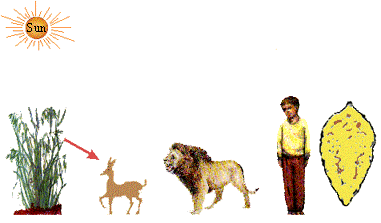Even though the basic requirement for nutrition
is the same for all higher animals, there is diversity in mechanisms
for intake of food. On the basis of how they obtain nutrition, living
organisms are classified into two main types :
Sun
-
Autotrophic,which prepare their own
food. These include photosynthetic and chemosynthetic bacteria
and photosynthetic plants.
-
Heterotrophic, which require prepared
organic substances as their food. All animals fall in this category.
They depend on plants or other animals for nutrition. This category
may be further subdivided into the as following groups:
a) Holozoic, in which animals take in their food in
solid and a non-diffusible form. Those which feed on plants are called
herbivores, like rabbit, cow etc., and those which feed on
other animals are called carnivores. The carnivores like lions
and tigers which hunt their prey alive are called predators,
while animals like vultures which feed on the dead animals are known
as scavengers. Other groups of animals like cats, dogs, humans,
etc. which feed both on plants as well as animals are called omnivores.

Food Herbivores
Carnivores Omnivores Parasites
Producers
Figure. 16.2 Diverse nutritional types
b) Parasites are those animals that live
in or on the body of another animal called host and obtain
prepared food from the host.
